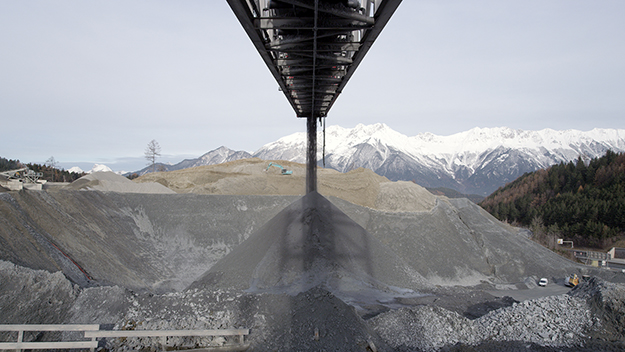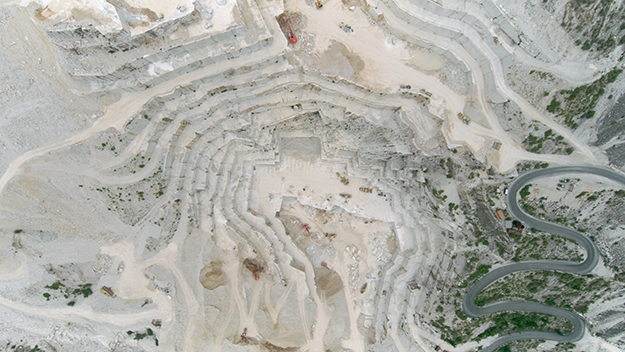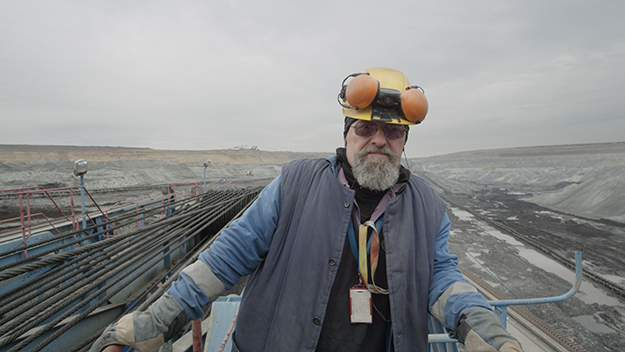Film of the Week: Earth

Images from Earth (Nikolaus Geyrhalter, 2019)
The subject of Nikolaus Geyrhalter’s Earth is exactly what the title suggests. It’s about the planet, but also the stuff—sod, stone, gravel, coal, marble, minerals. Most of all, it’s about mud—lots of mud, vast grey desolations of mud. The horror of Earth—and if ever a documentary was a horror story, this is it—is that our planet may still precariously be a multiplicity of rich, fertile, diverse environments, but that it’s increasingly, irreversibly being taken over by swathes of sterile murk, picked over by machines. A typical image in the documentary—one seen in several shots in different places round the world—is of seemingly unbounded expanses of freshly leveled or piled-up soil, on which little machines like toys scuttle around in the distance, or even smaller humans march along in fluorescent protective gear.
Photographed by the Austrian director himself (Our Daily Bread, Homo Sapiens), these images are sure as hell not beautiful, but they are spectacular, even awe-inspiring—in the sense of filling you with a sublime dread as you marvel that such destruction (sometimes in the guise of construction or renewal) could ever have happened. The film is about a simple topic, the way that humanity reshapes the earth’s surface—literally moving mountains, or at least tearing them down, sometimes with apparent disregard for the future well-being of the planet. Geyrhalter hits us at the start with captions and these simple statistics: “Every day 60 million tons of surface soil are moved by rivers, wind and other forces of nature . . . Humans move 156 millions tons of rock and soil per day, making humankind the most decisive geological factor of our time.” If those numbers are hard to get to grips with, here’s something simpler and more accessibly horrifying: the mountains in Tuscany where marble has been quarried since Roman times will, if work proceeds at its current rate, have vanished entirely in 300 years.
Earth belongs to the current cycle of environmental documentary that no doubt has already been dubbed “desolation porn,” in which we see spectacular images of natural structures and cycles, unchanged for millions of years, falling apart before our eyes: Viktor Kossakovsky’s Aquarela being a recent example. The seven stunning aerial shots, taken from directly overhead, with which Geyrhalter introduces each of his seven segments, also echo the images of photographer and filmmaker Yann Arthus-Bertrand (Home) in which tracts of the planet’s surface, seen from on high, become extraordinary abstract patterns. Geyrhalter’s landscapes similarly suggest the work of some singularly austere, perhaps scatologically inclined abstract painter: they are harsh, never beautiful, and look entirely static until you notice the tiny vehicles beetling around in them or, in one image, a sudden explosion blossoming in the corner of the screen.

The first stop in the tour—seven sites in Europe and North America—is an area of the San Fernando Valley, where the now inchoate gunk of the terrain will be replaced by “schools, parks, roads, shopping centers… Who knows?” says one worker. At any rate: “We’re building another town.” A number of affable laborers on the site explain to an off-screen Geyrhalter exactly what they do. If he meets a woman in a bar and she asks what he does, one guy tells us, he replies: “I move mountains for a living.” Another man, himself a cheerful mountain of beard and brawn, is seen at close quarters in the cab of his earth mover, pulling wheel and lever as he shuttles around his terrain, and we’re right in there with him: several sequences of Earth have the same immersive, fasten-your-seatbelt quality that you associate with the products of the Harvard Sensory Ethnographic Lab. His work, the man tells us afterward, is one long bumpy, brutal ride. “Once we get here,” he says, “it isn’t nature any more. Sometimes you got to move things around just to get stuff done.” As a boy, he played with Tonka Toys—a chunky range of plastic diggers and bulldozers that used to be advertised as “real tough toys for real tough boys”—and from a distance, tiny Tonkas is what they resemble.
Not surprisingly, a certain amount of male agonism underlies the rhetoric of work. “I’m basically in a street fight all day with my machine,” says Tonka Man. “The earth is a cruel mistress—she fights us all the way.” It’s not the only sexual language we hear in the film; a worker at the Carrara marble quarries in Italy, enthusing about the adrenaline rush of a surpassingly dangerous job, says: “We get to touch this material that no one has touched before… the outer crust is like the virginity of the mountains.”
Other interviewees come across as more sensitive, more rueful or more optimistic. A hard-hatted operative in the Brenner rail tunnel between Austria and Italy comments:“You feel a bit like an astronaut because you’re the first human to come across this spot.” But he adds: “Nature has not taken us into account for millions of years . . . We drill through the mountain and hope nature will play along.” A geologist at the Rio Tinto mines in Spain enthuses about her work, as she explains new environmentally friendly mining techniques. “We don’t know what’s down there,” she says. “We keep exploring… I think that’s fun.” Less sanguine is an archeologist at the same site, musing on the spiral theory of history by which empires rise and fall and by which, he assures us, ours will fall too: “I don’t think that Earth gives us anything easily… Extracting anything from the soil is a violent process.” His thoughts are borne out by a worker at the coal mines in Gyöngös, Hungary, where digging often unearths crystallized swamp cypress trees, millions of years old. Sometimes, if the trees don’t mangle the digging heads—which, in one image, suggest a ravening hydra—they just get mangled themselves. The trees, says the worker, are “just obstacles in our way that have to be removed.”

I’ve stressed the ugliness of what Geyrhalter finds, but there’s beauty too—however tragic—and much weirdness. A strange welding operation goes on underground at Brenner, resembling some arcane ritual in a Matthew Barney performance film, and is followed by a ceremony for St. Barbara, patron saint of mines: the blowing of an alpenhorn precedes a mighty timed explosion (there are as many explosions here as in your average Michael Bay movie, and they’re real, sometimes screen-shakingly so). The Carrara quarries are genuinely majestic, the mountains carved into giant staircases or hollowed out to create vast luminous temples, with orange hi-vis figures pacing around like miniscule priests.
Nothing in Earth is quite as unnerving as what we learn in the more cramped confines of a site at Wolfenbüttel, Germany, where a film is projected about methods of disposing of nuclear waste: it shows yellow barrels being dumped into pits at this former salt mine, then salt piled on top. This was formerly thought to be a safe storage method, and one solemn boffin says that underground is still the best place, but that there are problems. As his colleague explains, thousands of cracks and fissures in the earth allow water to seep in, and scientists are now trying to safeguard against the possible leakage of radioactive liquid. They are currently trying to predict all possible scenarios for the next million years. It’s about the only time in the film that you get any sense of wise foresight, as opposed to the future being dismissed with a shrug; “The children of our children will have to find something else,” says a man at Carrara, which sounds either desperately callous or just coldly realistic.
Geyrhalter’s final stop is Fort McKay, Canada, where it’s harder to get access to the mining site: “They don’t want the world to see how ugly it is,” says his guide Jean L’Hommecourt, a member of the indigenous Dene people (she is described online as a “traditional land use researcher”). There is stark spectacle in this section, but here it’s more a question of bleak facts: images of the junk left behind when industry first moved in on the Dene land (a work camp contaminated by asbestos, a dumped bulldozer from the ’40s), and simple grim news, like the official warning to avoid eating fish from the polluted river. “They’re hurting Mother Earth,” a First Nations man comments, hurting her with “big wounds.” The damage we see, of course, is often the flip side of profitability and some sort of cosmetic regeneration, or the hollow promise of it. “Agriculture and wild game will return,” a site worker at Gyöngös says, with a grin, and a gesture suggesting that he doesn’t believe it for a minute. The man from Fort McKay says: “They say they’re going to reclaim—but no one can reclaim the world.” By the time Earth has come to this sobering conclusion, it leaves you wanting to see Greta Thunberg, or some other emissary of the planet’s future, rise up over those slag piles and utter an imperious “Enough!” If only, if only…
Jonathan Romney is a contributing editor to Film Comment and writes the Film of the Week column. He is a member of the London Film Critics Circle.







